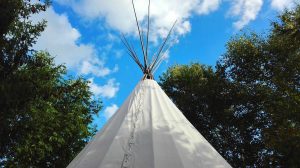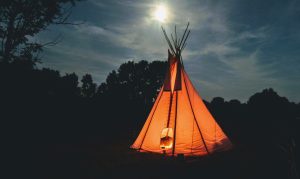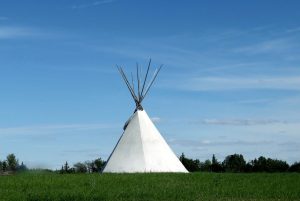
Trying out an Indian tipi when you camp is a perfect idea to be one with nature like the Indians. On top of the comfortable and unforgettable camping experience, you will be amazed by the mystic and charm these tipis offer.
It’s recognized as one of the best tents because it is easy to assemble, spacious, and adaptable to different weathers. The Tipi stays cool in the summer because the ventilation allows air to circulate between the inner and outer tent. You can build a small fire inside to keep it warm and cozy in the winter. It is resistant to rain and wind as well.
This article will help you discover why it is one of the best-designed homes for camping.
What is a Tipi?

The word “tipi” means “home” or “place to live” in the Dakota Indian language. Tipi, also spelt tepee, is a tall, luminous, and conical tent most familiar to the North American Plains Indians. Several Native American tribes used the same structures during the hunting season. However, most Plains Indians considered tipis as year-round dwellings during the 17th century, particularly the mounted nomads, because they could easily disassemble and transport it.
Native Americans used tanned animal hides from buffalo, antelope, elk, or bison to make tipis and wooden poles from pine trees for structural support. Chum, goahti, laavvu and kota are variations of what we know as the Tipi.
History of the Native American Tipi

Researchers and archaeologists found evidence of tipi dwellings dating back to 10,000 BC – the prehistoric era of mammoth hunters and gatherers. They have unearthed fragments of wooden poles from what they believe to be a village of tipis. Wandering tribes throughout the world used tipis as temporary homes. Still, the most widely known and acknowledged tipis are those of the Native Americans, specifically the Plains Indians and their “wigwams”.
Based on the archaeological remains and travel logs, you can visualize the first Tipi as two sticks covered with some hides to protect the lodger from the sun, rain, or wind.
The shape and structure of tipis have evolved throughout the years. Clans and tribes had gradually modified their tipis to suit their nomadic lifestyle and needs until, ultimately, the tipis looked like what it is today. Although the design of tipis has drastically changed over the years, the overall concept hasn’t changed much.
People who took part in Francisco Vázquez de Coronado’s expedition in 1540 described the tipis they saw in the Native American camps of the Southwestern tribes as much smaller than customary. With the arrival of the Appaloosa horse, the tribes started to hunt bison on horseback and obtained pelts and food in abundance. As their supplies grew, the Tipi grew more extensive for storage – from around 13 to 16.5 feet and 26 to 29.5 feet in diameter.
Structural Design of the Native American Tipi
The typical Native American Tipi has a conical tent design. The conical tent is not unique in North America but is also common to native cultures across the Northern hemisphere. Tipis come in various sizes, from three to nine meters, that could accommodate up to 40 persons.
Its slightly elliptical shape and internal frame allow more space and standing headroom in the rear of the Tipi. At the same time, it places the middle part of the Tipi under the opening in the smoke flap. Its steep walls and internal linings protect you from wind, rain, and snow. It also has layers of insulation you can add during deep winter.
Tipi’s most iconic and distinctive feature is the inventive smoke flap design on top of the structure. It regulates the smoke from the small fire inside the Tipi to escape freely regardless of wind direction.
The Tipi’s incline, the design of its smoke flaps, and the circular doorways were unique to every tribe and adapted to the particular climate in which they lived. Generally, the overall features of the Tipi have aesthetic and practical importance.
The women of the tribe assembled and moved the tipi homes. They were in charge of choosing the location and organizing and arranging the village. The tipis were generally easy to set up and disassemble, facilitating migratory movements.
As a practice, the Native Americans always raised their tipis, pointing towards the East, where dawn breaks. The tipis are more than just a home for Plains Indians. They consider it a sacred space, with each part symbolizing something about the universe. The circular shape of the Tipi is a symbol of the interconnection of all things. The tent’s floor signifies Mother Earth, the ceiling as the Sky, and each pillar of the Tipi represents the portal that connects man and the Great Spirit. The Native Americans used a small altar made of stone or earth for burning incense during prayer times.
Basic Components of a Tipi
A basic Native American tipi consists of the following:
- Cover
- Liner
- Ozan
- Poles
- Smoke Ventilation Flaps and Cover
- Rollable Door
- Pitching Accessories
Let’s discuss each one in detail.
Cover
The tribes built their cone-shaped tents using hides of animals they hunted. Some were made from reindeer or caribou hide, while Native Americans used buffalo hides. The Native American Tipi evolved into the Bell Tent and the Sibley Tent.
The functionality of the tipis varies based on the materials used. Today, modern tipis use high-performance materials such as canvas, nylon, or plastic-coated fabric like vinyl. Synthetic plastic tipis are cheaper to produce but lack breathability and easily collect moulds and mildew. The most preferred material to cover a tipi is cotton canvas. Moisture, snow, and high temperature also play an essential part in choosing the materials—the thicker the material, the more robust and more durable the tent.
Liner
The tipi liner helps to improve ventilation and prevents water from dripping in during rainy spells. It also provides added privacy and security aside from the cover. You can stuff grass between the liner and the cover during the cold season to provide insulation.
Ozan
An Ozan is an interior awning that extends from the top of the tipi liner forward into the Tipi. It is fixed to the roof and hanging above the lining. Its function is to maximize comfort and protection from raindrops that can get through rods.
Poles
In the past, poles were made of peeled, polished, and dried tapering saplings, particularly pine trees, cut to measure about six feet. Wooden poles from Lodgepole pine are the preferred wood for making tipis in the Northern and Central Plains while the red cedar in the Southern Plains.
Historically, a typical family tipi had at least thirteen lodge poles from 12 to 25 feet or 3.7 to 7.6 meters long as the frame. These poles are tied together at the small ends and raised upright in a way that crosses the poles.
Some tribes built their tipis with single poles that rely mainly on canvas’s tensile strength, guy lines, and stakes. Single-pole tipis are easy to pitch, move from one place to another, and are the best fit for camping and glamping.
Traditional 12-pole tipis are what most people think tipis should be. They have an opening on the top where the poles meet, traditionally used to vent smoke from fires built inside the Tipi during winter. This style of tipis still exists but may not be the best shelter in times of heavy rain. However, a hide or fabric ceiling can reduce the problem.
Smoke Ventilation Flap and Cover
The Native American Plains Indians devised a smoke flap ventilation on their tipi housing to regulate the smoke from the small fire created inside it during winter or ceremonial events. The vent is sewn permanently to the cured hides, covering the outer part of the huge tipi structure to prevent rain from coming in.
Rollable door
A separate covering was always positioned over the eastern side of the teepee to serve as the front door. The Tipi’s entry would be rolled open by the dweller to welcome visitors. You need to ask permission to enter when the door is closed, even if you live there.
Pitching Accessories
- Ropes and Wooden Pegs
- Lacing Pins
Ropes and wooden pegs bind the poles together, close the cover, secure smoke flaps, connect the lining to the door, and anchor the resulting structure to the ground. The nomads used ropes made of rawhide.
Hand peeled, willow lacing pins weave the lacing pin holes up the front of the Tipi holding the two sides securely together. They are extended from above the door to the smoke hole to hold together the Tipi. The Nomads used the last two poles to hold open the smoke flaps.
Assembling a Tipi
Traditionally, women were responsible for setting up and maintaining the tipis for their tribes. In raising a tipi, they would begin with three to four poles that serve as the keystones of a conical framework. Twenty to 30 more poles, all leaning toward a central point and tied together, were added to augment the structure. The top was left open with an adjustable flap that served as ventilation to release the smoke from the small fire created inside the tipi. They also devised an opening at the bottom with a covering to serve as a doorway.
The women then covered the framework of wooden poles with eight to 12 dressed buffalo hides or, depending on the tribe’s preference, reed mats, canvas, or other materials.
Tipi tents were typically 15 to 30 feet in diameter and 12 to 20 feet high, while some had larger structures. When huge shelters were required, two-pole frameworks were set side by side in a figure of eight, with poles and covers left out of the connecting walls.
Types of Native American Tipis

The Tipis of every tribe vary in their character and creativity. Variations of tipis are primarily because of the smoke flaps and the number of poles used by the tribes for the initial framework. The most common prototypes are:
Dakota Tipi: This Tipi has a notable vertical structure that quickly helps the rain rollover. A rope secures the top area where the crossbars meet. The tribes structured the oval base between 12 and 15 long poles. It is multi-functional and considered the easiest to repair among other types of tipis.
Crow Tipi: The Crow tribes pride themselves on the beauty and size of their tipis. This four-pole Tipi is probably the most aesthetically designed tent. The size of its overlapping flaps, used to release smoke from the tipi, provides symmetry with the Tipi’s almost conical shape.
Blackfoot Tipi: The Blackfoot Tipi’s design is unique compared to the other two types. Its shape is less vertical and is most effective in dry and windy areas. It uses four-pole support, and the smoke flaps are shorter than a Crow tipi. Because of its large upper opening, rainwater can quickly come in where the smoke exits. It also takes longer to set up, disassemble, and repair.
Every tribe and clan had some peculiarities in creating their tipis, driven by their myths and cultural references. Please note that a tipi is not the same as a wigwam – a wigwam is more like a bender.
Weddings in Tipis
Tipis nowadays are not just for shelter and camping but also for celebrating special events like weddings. Las Vegas, one of the top gambling cities in the USA, may offer glamour and excitement, but for those who value peace and tranquility, a Tipi could be the perfect venue. Couples with or without a Native American background often incorporate Native American culture and tradition into their ceremony to honor the rich American heritage and make the event truly unique.
Consider these important things if you’ve set your heart on a tipi wedding:
Venue. Choose the perfect place for your tipi ceremony. A scenic backdrop and a beautiful view as the sun goes down on your special day will make all the difference.
A connection with land and nature is the cornerstone of Native American tradition. This type of wedding is usually held outdoors with natural and spiritual elements like wood and rocks, honouring the Native American culture. Venues like national parks, gardens, and areas with rivers, lakes, waterfalls, can be the perfect location for the ceremony and reception.
Lighting. Proper lighting goes a long way to add that magical atmosphere when celebrating your wedding in a tipi. Well-lit pathways from the parking area to the Tipi will look fabulous and, at the same time, promote safety to all guests.
Facilities. Ensure that your selected venue has everything you need — from generator supply to toilet facilities and other essential pieces of the puzzle.
Number of Tipis. You need to know how many tipis you need for the occasion. Would you need separate spaces for the bar, eating, and dancing?
Decoration. Take this opportunity to make the overall design reflect you and your partner’s personality to augment the magical feeling a tipi wedding can bring.
Rituals
Vase Ritual: The groom’s parents make a wedding vase made of clay with two separate spouts. The couple will drink from the two different spouts to signify their individuality while drinking from the same vessel symbolizes their union.
Blanket Ritual: There are different ways to perform the blanket ritual, but basically, the bride and the groom are wrapped in their blankets, symbolizing their single lives. After the officiant blesses the couple, the separate blankets are removed and replaced with a single white blanket wrapped around the couple.
Smudging: In the ceremony, the couple use sage and ritualistic flowers during smudging. The smoke is said to carry their prayers to the Creator and cleanse the couple and their officiant.
Food and Vows: Food is an essential part of the wedding ceremonies of many Native American tribes. Brides usually offer a basket containing an ear of corn or a loaf of bread, while the groom provides a basket with a slice of cooked meat to indicate his ability to be a good provider. These food offerings symbolize their commitment to one another in building a home together.
Conclusion
The Tipi embodies a cultural context that allows us to be with the natural world. It represents the rich Native American heritage and their way of life on earth, which we must appreciate and learn from in these modern times. Tipis are becoming more popular for camping with families and friends and celebrating special occasions like weddings. You may want to explore and experience the charms and mystics it brings.